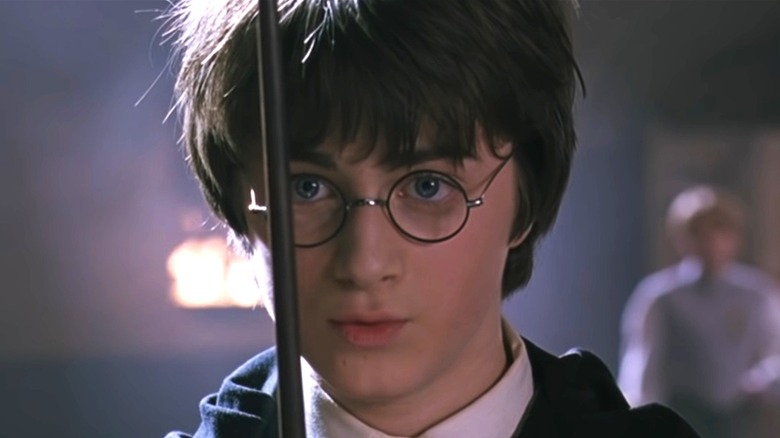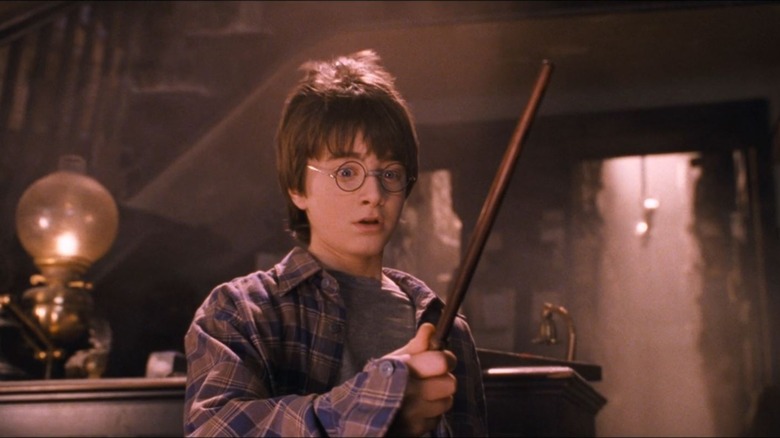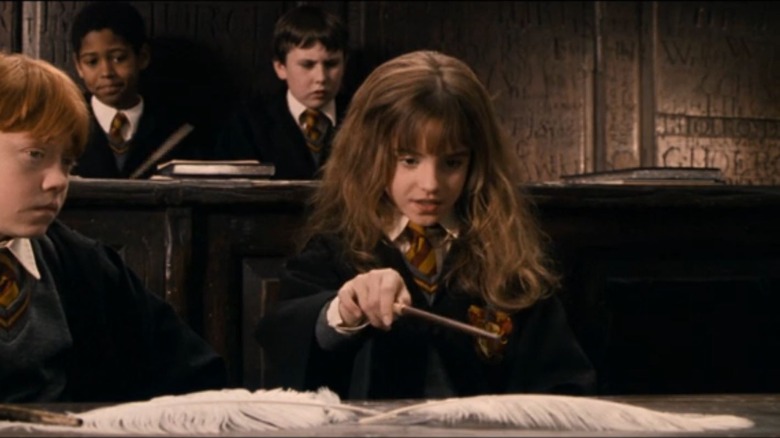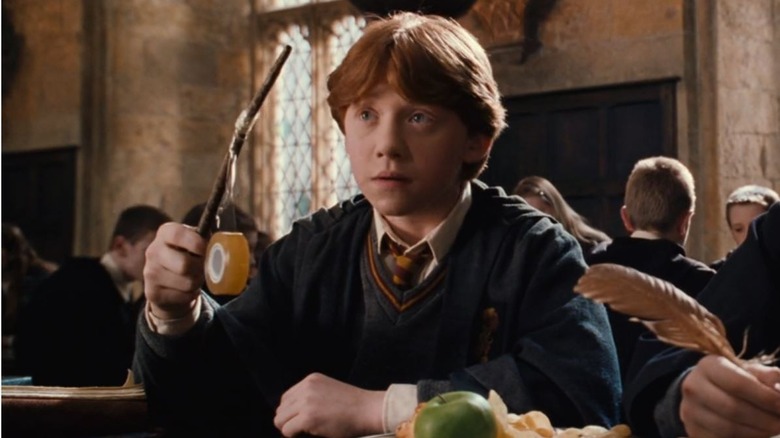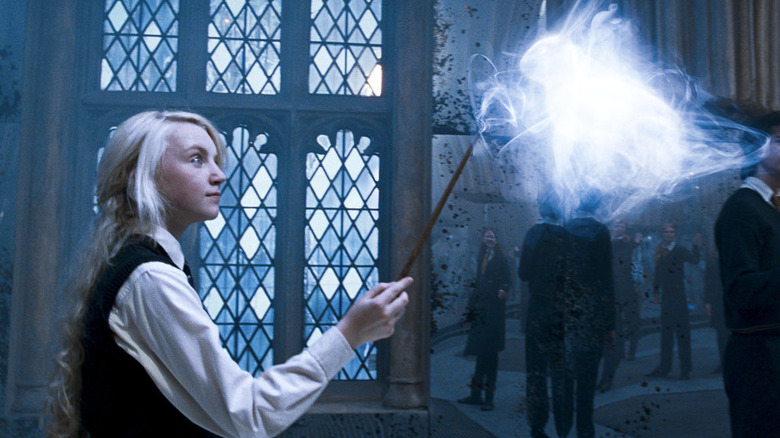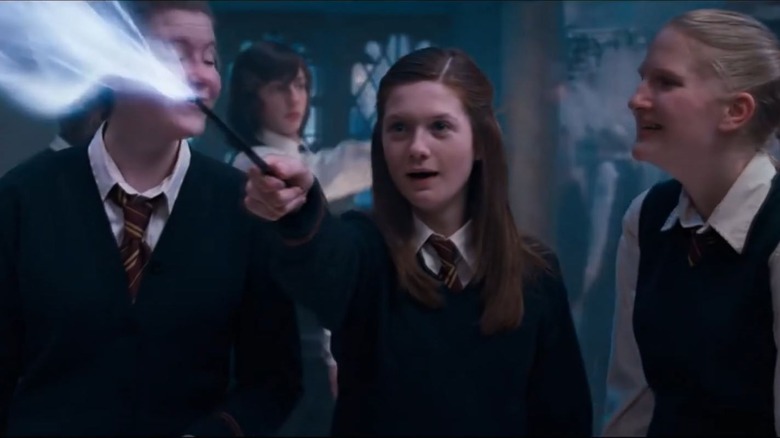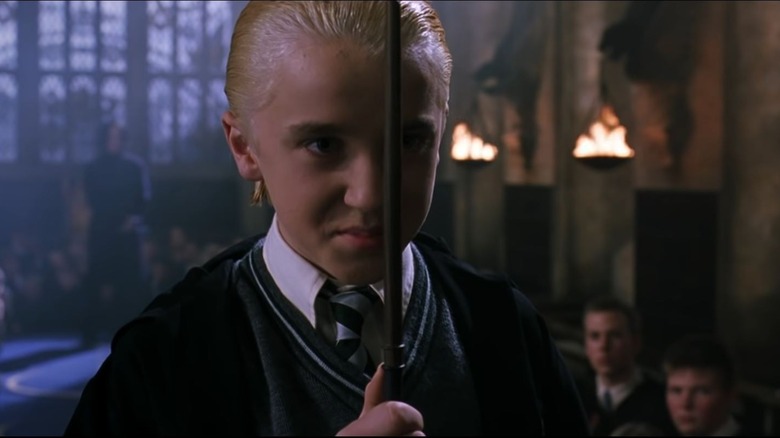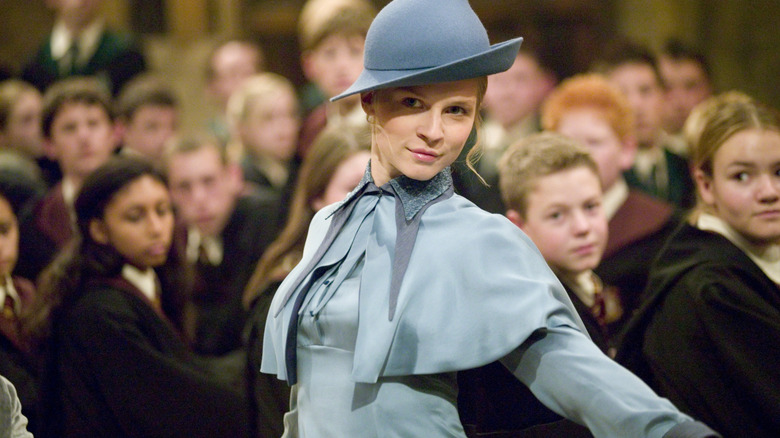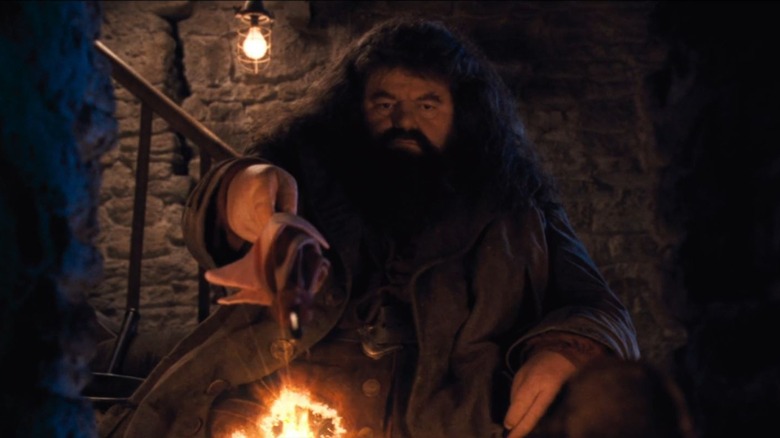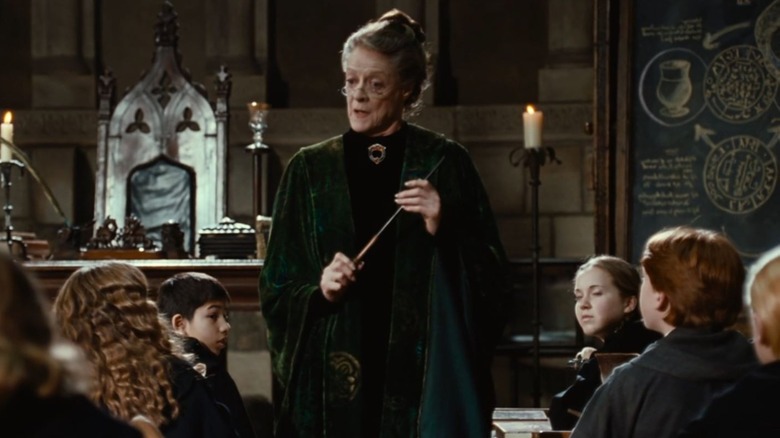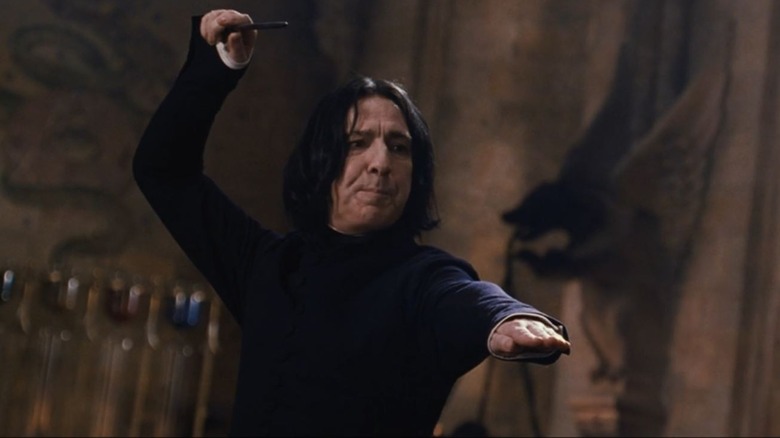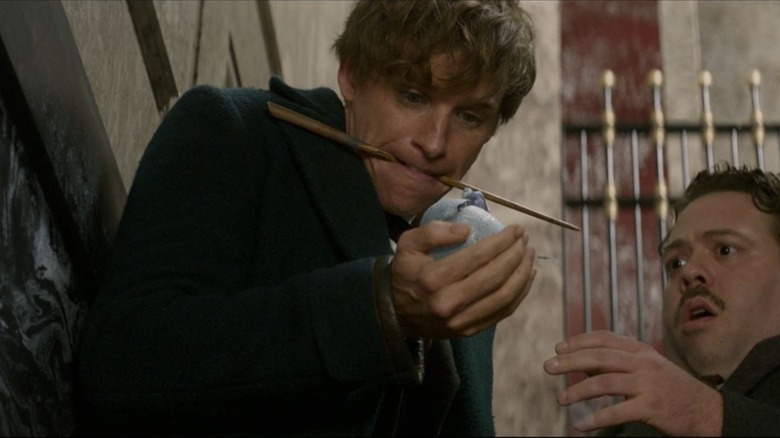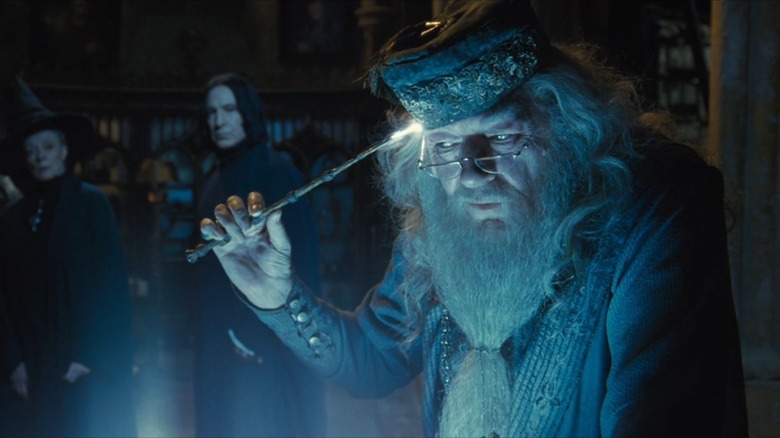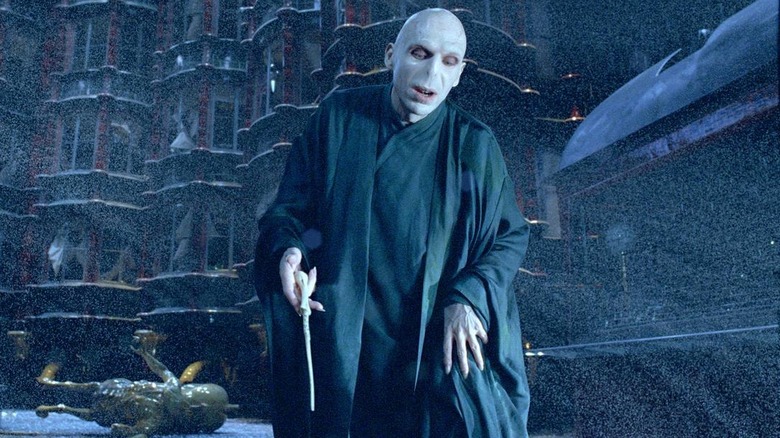Every Main Character's Wand In Harry Potter Explained
In the Wizarding World of the "Harry Potter" series, it doesn't matter how powerful, skilled, intelligent, or knowledgeable a witch or wizard is, they still need a wand — one made by skilled craftsmen from across the world using an incredible variety of different woods filled with a magical substance of one kind or another that act as its "core."
Semi-sentient at a minimum, the exact nature and temperament of a wand could differ dramatically based on the components used to create it. Not every wand will work well for every magic user, a fact that can make selecting wand less like browsing at a store and more like auditioning until one chooses you.
Because of this, the stories of each main character across the series are heavily reflected within their wands, whose unique composition often reflect aspects of their personality and demeanor that might otherwise have gone unnoticed. With this in mind, here's every main character's wand in "Harry Potter" explained.
Harry Potter
Olivander giving Harry Potter his first wand is of the most iconic scenes in "Harry Potter: The Sorcerer's Stone." In the film, the music swells and the air swirls around the boy as the wand chooses him, but the little celebration is sharply ended when Olivander reveals that Harry's 11-inch wand shares a deep connection with Voldemort's, much like the boy himself.
The cores of both wands were made using the only two feathers that Albus Dumbledore's personal phoenix, Fawkes, ever allowed to be taken. Because of this, when the mortal enemies clashed, the wands would recognize each other as brothers and create a "reverse spell effect" that would blow up in Voldemort's face and even allow Harry's wand to absorb a portion of the dark lord's skill and prowess.
Harry's wand was made using holly, a type of wood used relatively rarely within the wizarding world. According to tradition, holly is especially adept at providing protection and repelling evil, and the people that holly wands choose are typically kind, loving leaders.
Harry uses his wand throughout every book until, in the seventh and final entry in the series "Harry Potter and the Deathly Hallows," it's accidentally broken when a spell cast by Hermione Granger hits the wand as well as the villain attempting to kill Harry. Though saddened by the loss, Harry is ultimately able to repair it using the Elder Wand, which is able to perform feats that are otherwise impossible.
Hermione Granger
Of all the characters in the series, Hermione Granger has a wand that reflects her rather perfectly. It was made using vine surrounding a dragon heartstring core, both of which are rare and exceptional materials that enhance some of Hermione's best qualities.
Vine wands are said to gravitate toward witches and wizards "who seek a greater purpose, who have a vision beyond the ordinary and who frequently astound those who think they know them best." Hermione's dedication to helping and protecting her friends is only matched by her fierce determination to be the best student at Hogwarts in every subject, and she frequently surprises those very same friends throughout the series because of this.
Dragon heartstrings, on the other hand, create the most powerful wands in the wizarding world and are capable of the most "flamboyant" spells but can also be temperamental, requiring their users to exhibit a great deal of mastery in order to avoid unintended accidents. Hermione, with her incredible intellect and perfection of technique, is perfectly suited to pursue her "greater purpose" of higher learning to utilize the power of the dragon heartstring core to its full potential.
Hermione uses this wand throughout the series until the final book, when it's taken after she, Harry, and Ron are captured by "Snatchers," bounty hunters who serve Voldemort. Though the trio escape, Hermione is unable to retrieve her wand, and it's unknown whether she's able to find it again.
Ron Weasley
Of all the characters on this list, Ronald Weasley probably has the worst luck with wands. His first wasn't even purchased or chosen for him; it was a hand-me-down from his older brother, Charlie. The 12-inch wand is made of ash with a unicorn hair core, and though it works for Ron, it doesn't do so especially well — and it stops working completely after it's snapped in half during his second year at Hogwarts, when he and Harry crash into the Whomping Willow. His inability to replace this broken wand ultimately saves Harry, Ginny, and Ron's lives, as it causes Gilderoy Lockhart's memory-wiping spell to backfire and wipe his own mind, allowing the boys to defeat the Basilisk and save Ginny.
Ron's second wand suits him much better — 14 inches long and made out of willow and another piece of unicorn hair. Though often associated with healing, willow wands choose users who are exceptionally faithful to their friends but struggle with some acute insecurity. Similarly, unicorn hair cores produce the most consistent magic but don't make for particularly powerful wands and can be prone to melancholy, all of which matches Ron. As is the case with Hermione, Ron's second wand is taken by Snatchers, and it's unknown if he ever recovers it.
Luna Lovegood
There are many main characters from the "Harry Potter" series whose wands are never discussed in any detail. The length, material, and core of Luna's wand is simply never mentioned in any of the books, films, or expanded media. A person with a unique perspective on and insight into the wizarding world, Luna becomes one of the central members of Harry's group of friends during their fifth year (her fourth) in "The Order of the Phoenix," and is one of Ginny Weasley's best friends.
In the films, Luna's first wand uses acorns as a part of its design, which might indicate that it was made of oak. English Oak specifically would fit quite well with her character, as it typically chooses users who are loyal, powerfully intuitive, and in touch with the natural world and its magical creatures.
Despite often appearing absent-minded, Luna is incredibly perceptive. When Harry attends Bill Weasley and Fleur Delacour's wedding in the seventh book, she recognizes him immediately even though he's disguised as a cousin of the Weasleys using the shape-shifting Polyjuice Potion. Similarly, after she graduates, she shows her affinity for nature when she becomes a magizoologist who discovers numerous new species.
After she too is captured by Death Eaters, she loses this wand, but after she helps Harry, Ron, and Hermione break free, her fellow prisoner, Garrick Ollivander, creates a new wand for her out of thanks.
Ginny Weasley
The youngest of the Weasley children, Ginny is quick-witted, clever, and sharp. She's never afraid to stand up for herself and others, and many bullies discover the hard way just how good Ginny is at various curses and hexes, especially her favorite, the "Bat-Bogey Hex," which turns mucus inside a person's nose into flying bats.
Rather appropriately, the only thing fans know for certain about Ginny's wand is that it was made out of yew, a wood notorious for being especially suited for dueling and inflicting curses, two skills the youngest Weasley excels at. Yew wands tend to choose those who either are or will become fierce fighters, and this particular Gryffindor student proves time and again that she's always brave enough to fight to protect those she cared about. Supposedly, these wands never choose owners who are "mediocre" or "timid," and this certainly holds true with Ginny.
Draco Malfoy
Measuring 10 inches and constructed out of hawthorn wood and a unicorn hair, Draco Malfoy's wand is as exquisitely polished and refined as he believes himself to be. Wands made of hawthorn wood often choose wizards who, though complex, struggle with conflicting natures. The wood is especially suited for curses, but if handled poorly, it can cause spells to backfire.
During the "Harry Potter" novels, Draco consistently shows his conflicting nature, especially in the final two books. Though he's a cruel brat throughout, when push comes to shove, he discovers that he isn't as mean-spirited as he wanted to believe, and he certainly isn't evil. Voldemort has to hold his parents hostage to persuade Draco to murder Dumbledore in "The Half-Blood Prince," but he's unable to go through with it, forcing Severus Snape to do it instead in order to spare Malfoy. After the Battle of Hogwarts, Draco thoroughly rejects the ways of Salazar Slytherin, Voldemort, his own father, and even his former self, and raises his own son to be the kind of person he wishes he'd been.
During the final entry in the series, "The Deathly Hallows," Malfoy loses his wand in a duel with Harry Potter, who takes it and uses it as a replacement for his then-broken wand. It's unknown whether Harry returns it to Draco.
Fleur Delacour
When the Beauxbatons Academy of Magic from France and the Durmstrang Institute travel to the Hogwarts School of Witchcraft and Wizardry to take part in the Triwizard Tournament, Fleur Delacour is chosen as the French academy's champion. Blunt, intelligent, perceptive, and highly skilled, Fleur is ultimately just as unique as her wand.
It's nine and a half inches long and made using the relatively uncommon rosewood, but its singular core, a single strand of hair from a veela, truly sets it apart. Veelas are mystical beings who are both famous and infamous for their otherworldly beauty and their ability to use their magic to charm, seduce, and otherwise coerce the will of any human attracted to women. They're known to fall in love with and marry wizards, as Fleur's veela grandmother had done decades prior.
She's part veela herself because of this, and Fleur's wand was made using a single strand of her grandmother's hair, tying the wand tightly to her family and their history — though, according to Olivander, the use of veela hair makes wands temperamental and inflexible.
Rubeus Hagrid
Rubeus Hagrid's wand has one of the saddest stories of any wand in the Harry Potter saga. A half-giant on his mother's side, Hagrid always has a hard time fitting in, but his exceptional physique proves quite useful in helping him survive his intense fascination with dangerous magical beasts. At 16 inches long, Hagrid's oak wand is suitably massive, and just as sturdy as he is. Unfortunately, both his wand and his time as a student at Hogwarts are cut cruelly short by Voldemort during Hagrid's third year at the school.
In order to keep the Chamber of Secrets away from prying eyes and hide his own involvement, Voldemort, then still known as Tom Riddle, frames murders he's committed on a giant magical spider that Hagrid has been secretly taking care of. As a result, Hagrid is expelled, his wand taken from him and broken in half — though he keeps the pieces and puts them in an umbrella, allowing him to perform magic on the sly without being caught.
Minerva McGonagall
The head of Gryffindor House, Minerva McGonagall is Hogwarts' transfiguration professor; her wand is 9 1/2 inches long and consists of a dragon heartstring housed within fir wood. Like Minerva, wands made from fir are resilient, and they choose owners who possess a strength of purpose that is not plagued by indecisiveness. Fir wands are ideally suited for transfiguration spells, and its wielders are typically "focused, strong-minded and, occasionally, [possess an] intimidating demeanor."
This describes McGonagall perfectly, and it only makes sense that her command of respect and air of authority are just as powerful as the dragon heartstring that holds her wand together. Like Minerva, her wand is "elegant, refined and very powerful," and given the fact that, despite her age, Minerva not only survives taking four stun spells to the chest at once in "Harry Potter and the Order of the Phoenix" but also survives the Second Wizarding War unscathed, the reputation of fir wands as "survivor wands" is well earned.
Severus Snape
Severus Snape is one of the most beloved characters in the entire "Harry Potter" series, and yet, somehow, virtually nothing is known about his wand. Like the character's costuming, Snape's wand in the films is simple, unadorned, and dark, though the short handle base does have some intricate designs carved into it, possibly hinting at the unseen depth of Severus' character.
Snape is a childhood friend of Harry Potter's mother Lily, and though the two grow apart during their joint time at Hogwarts, Severus never forgets his love for her despite the many cruel torments that her future husband, James, inflicts upon him. Cynical and bitter toward the world because of the horrific treatment he's received, Snape joins Voldemort during the First Wizarding War, but as the conflict drags on, his increasing concern for Lily's safety causes him to switch sides and become a spy for Dumbledore in the hopes of keeping her safe.
Snape uses this wand throughout both the First and Second Wizarding Wars, and for the entire "Harry Potter" series, until his death at the hands of Voldemort in "The Deathly Hallows." It is unknown what happened to his wand after his passing.
Newt Scamander
The main character of the "Fantastic Beasts" series of movies, Newt Scamander is a remarkably kind and gentle person whose easy and earned rapport with mystical creatures is a joy to watch unfold onscreen. Surprisingly, however, there is no official information regarding the make or composition of his wand.
Thankfully, there's plenty of unofficial information for fans to sift through thanks to the character's actor, Eddie Redmayne. In one interview, a sea shell is said to have been used for the wand's handle, and in another, Redmayne claims that his wand was made by Ollivanders out of ash wood and "mother of pearl." An ash wand would make a lot sense for Newt, as they tend to choose kind and generous people who see the beauty in every person, creature, and thing around them as Scamander does with his animals and his friendships, especially with Jacob Kowalski.
Interestingly, despite the fact that Newt was expelled from Hogwarts, he still has a wand and seems to be able to perform magic without restriction, unlike his fellow magical creatures enthusiast Rubeus Hagrid. It's unknown why this is case, or even if his current wand is his original or a replacement.
Albus Dumbledore and Gellert Grindelwald
Though both Gellert Grindelwald and Albus Dumbledore must have had their own personal wands at one point or another, both men are better known for wielding a different weapon altogether: the Elder Wand. Rumored to have been created by Death itself, this legendary artifact is one of the three Deathly Hallows and endows its user with the ability to perform magic that would otherwise be impossible.
The wand was made out of elder wood, the rarest of all wand wood types, using a thestral tail hair. Both are incredibly difficult materials to work with, and the wand is said to only work for those who understand and accept the inevitable reality of their own mortality. It's also said to only work for those who earn the wand in combat and will refuse to function for someone if it deems another wizard around them to be more powerful.
Having stolen it in combat from a wand maker named Mykew Gregorovitch, Grindelwald uses the wand throughout his entire reign of terror until Dumbledore finally defeats him in a legendary duel in 1945, making Albus the wand's new master, and he uses it until his death in "The Half-Blood Prince." Afterwards, Voldemort attempts to master it without success — he hadn't won it in combat, and he didn't know that it was Draco Malfoy, not Severus Snape, who disarmed the wand and thus earned its allegiance. When Harry beats Malfoy in "The Deathly Hallows," its allegiance transfers to him, and he uses it to repair his original wand after Voldemort is destroyed. Harry hides the wand away hoping that, if he can die a natural death, he might break its power.
Voldemort
Voldemort casts aside his given name of Tom Riddle to distance himself from his Muggle heritage and create a new identity of his own, but his 13 1/2 inch yew wand serves him well in both identities. He takes full advantage of yew's aptitude for dueling and curses, and he likely contributes heavily to its reputation as dark wizarding material that grants its users a special power over life and death.
The wand's powerful phoenix feather core comes from Dumbledore's own personal bird, Fawkes. Unfortunately for the Dark Lord, however, his eventual mortal enemy, Harry Potter, bonds with a wand that uses the only other feather that Fawkes ever gave, making the wands brothers — a fact that leads directly to his defeat in "The Goblet of Fire."
This is the wand that kills Harry's parents, and the dark lord uses it until he acquires the Elder Wand, though he never masters it.
